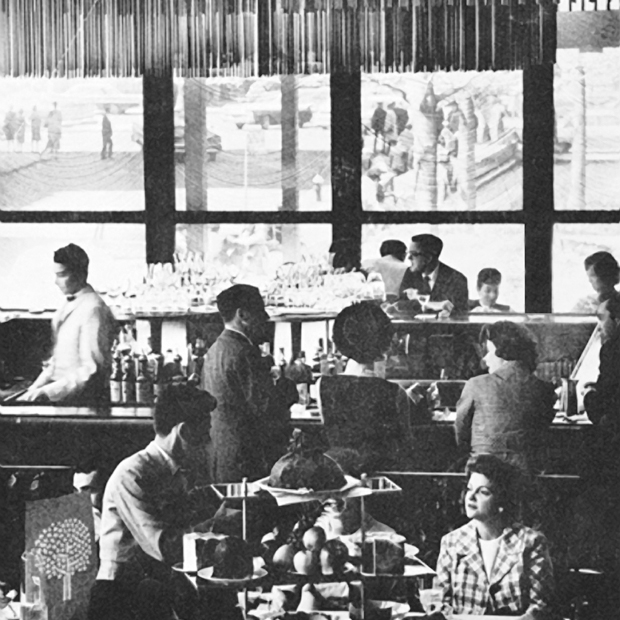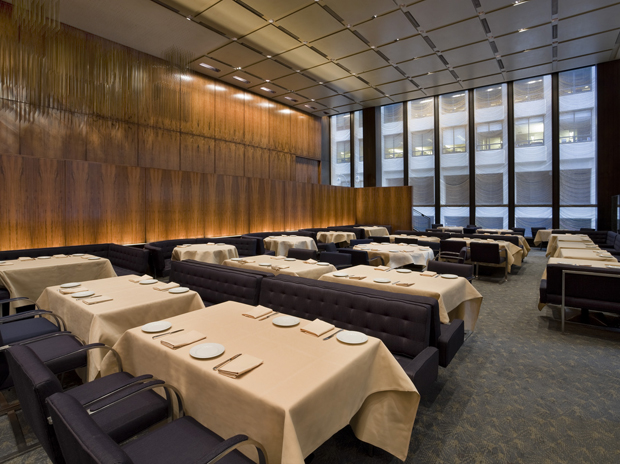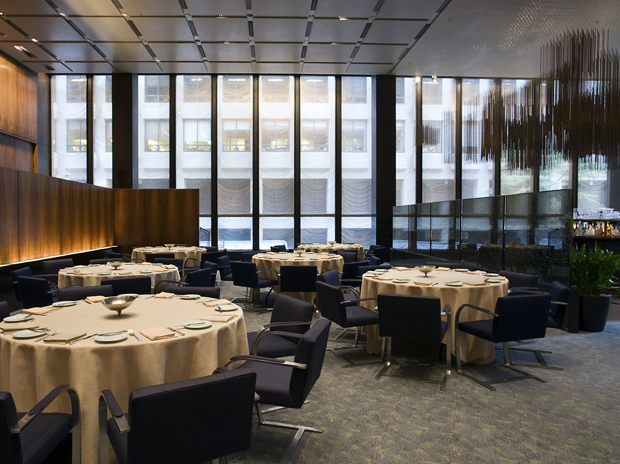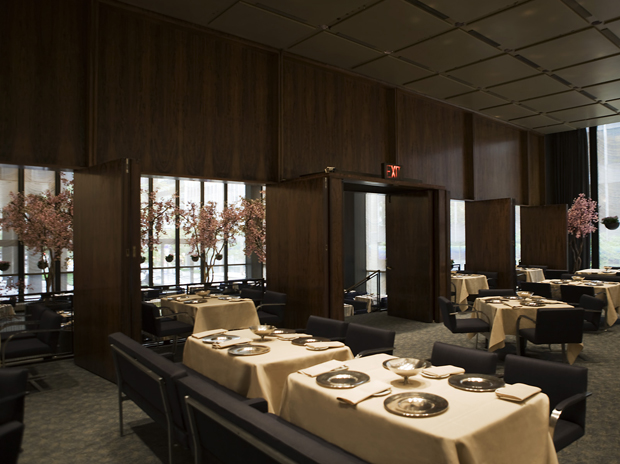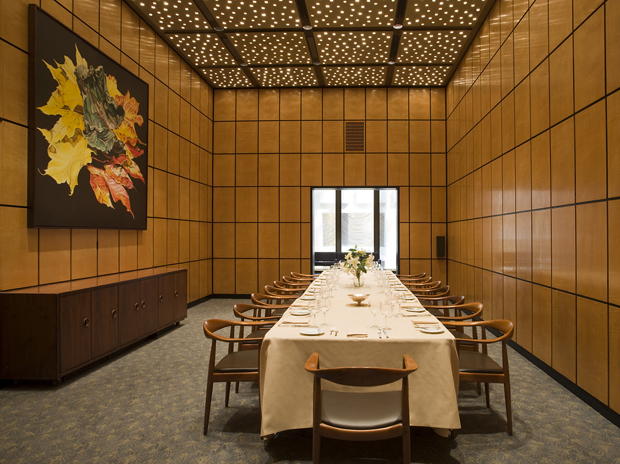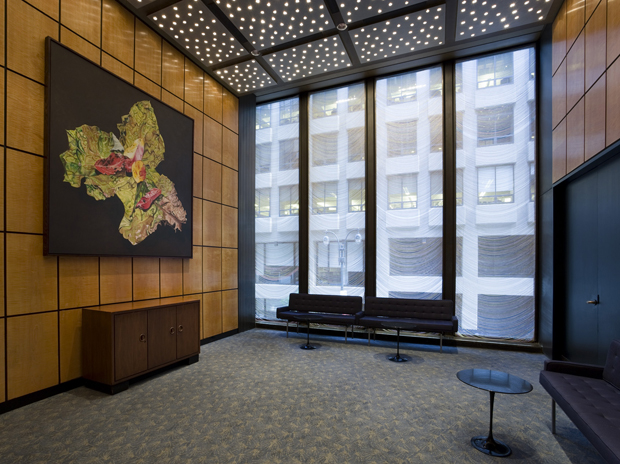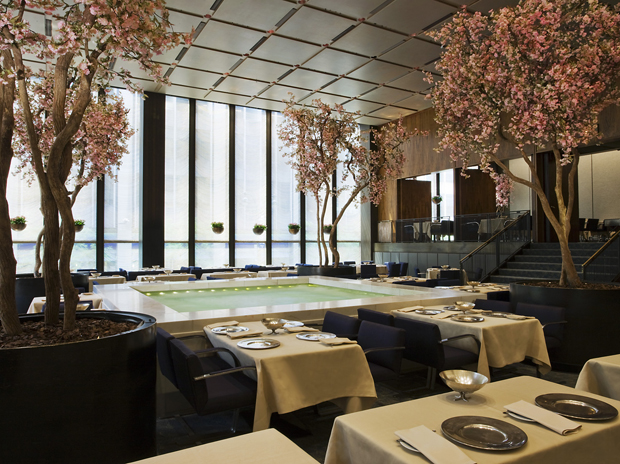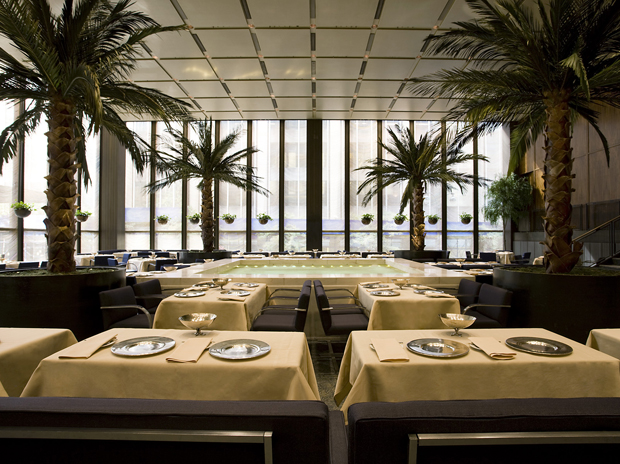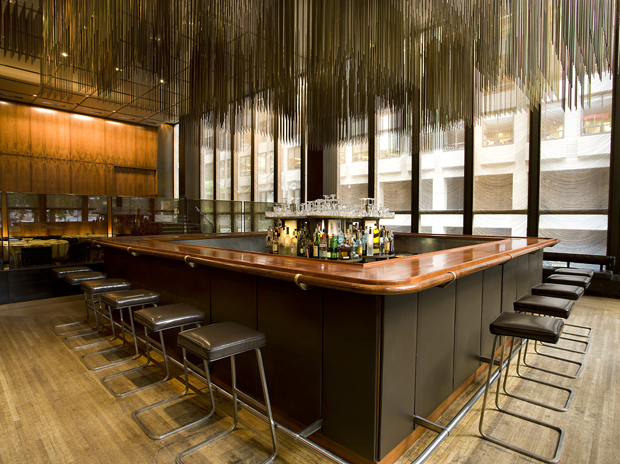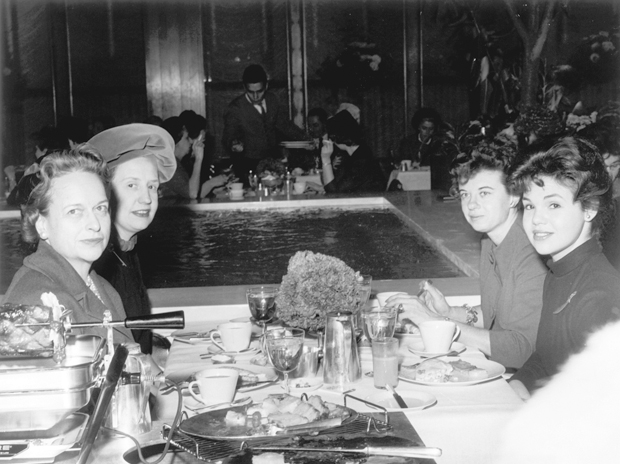power lunch
-noun
a high-powered business meeting conducted over lunch.
Collins English Dictionary
The term power lunch came to prominence at the beginning of the 1980s, and came to be one of the of the buzz phrases of that decadent decade that still resonates with a powerful sense of glamour and possibility. Lee Eisenberg's article "America's most powerful lunch" appeared in the influential Esquire Magazine in October 1979 and is credited by many as the first time the term was popularly used, the Four Seasons being perhaps the most recognizable name on his list. The image of multi-millionaires in braces talking stocks and shares over caviar does not, however, do any kind of descriptive justice to this cultural icon.
Rather than an “it-eatery” of a particular epoch, slipping in and out of fashion, the food unimportant and the environs unnoticed, the Four Seasons manages the rare feat of being both one of the world’s most recognizable and exclusive restaurants and a priceless cultural artifact. It is a timeless icon as important today as it was when it was unveiled in 1959.
The Four Seasons changed the face of American dining by overturning a number of conventions and unwritten rules. At a time when restaurants - even exclusive ones - were occupants of pre-existing spaces, the Four Seasons was the first custom built restaurant of its kind. In its recognition of the importance of cooking, dining and socializing as vitally important human activities whose specific needs and requirements demanded their own thoughtfully constructed spaces in order to function properly, this was a groundbreaking moment.
However, in keeping with the Four Seasons trademark extravagance, it was not merely custom built; it was designed by two of the most important architects of the twentieth century, Philip Johnson and Mies van der Rohe. The project formed part of a lifelong creative collaboration between the two men, founding fathers of what Johnson himself had helped to name the International Style - a celebration and exploration of modernism and minimalism that has influenced every aspect of architecture from the 1930s until the present day. The Four Seasons has since its very inception been a project born of a seemingly infinite sense of wealth. It was built at a cost of $4.5 million dollars, which in 1959 was a fortune. To put this into context, the entire Guggenheim Museum was completed the same year at a cost of $1.5 million dollars, one third of the price-tag for the Four Seasons.
At a time when restaurants were taking advantage of the jet age and importing ingredients from all over America and beyond, on grounds of freshness and taste, the Four Seasons chose to mold its menu around the highest quality locally sourced seasonal ingredients. To this day, no dish leaves the kitchen with ingredients that are more than a day from farm or shore. This focus on the finest, freshest ingredients lends the Four Seasons menu a sense of luxurious spontaneity. With its pioneering Barrel Tasting Dinners in the early 1970s, the Four Seasons was also the first elite establishment to champion American produced wines, from the Nappa Valley in California, which soon became recognized as world-beaters.
With the Four Seasons, Johnson and van der Rohe created a bespoke dream; an exquisite sensory experience. The iconic and timelessly classic interiors have remained largely unchanged since it opened, featuring two main dining areas; the Grill Room and the Pool Room. The Grill Room, an oasis of calm frenzy, is recognized as a New York phenomenon - still the home of the power lunch. Here is where some of the world’s richest and most powerful people have lunch with each other, and whilst billion dollar deals are rumored to be brokered, what is clear is that billion dollar relationships and collaborations are made and maintained at the Four Seasons. The opulent and yet discrete atmosphere allows diners of often staggering wealth, power and influence to feel a sense of comfortable parity while they tuck into exquisite, super-efficiently delivered, classic cuisine and discuss the business of the day. Since the restaurant’s inception, the room has featured the Four Seasons´ signature metallic chain curtains, a bi-level floor plan and the beautiful bass note of the walnut paneled walls. The Grill Room also contains the walnut sculpted Front Bar - another New York institution, renowned for Richard Lippold’s suspended bronze rod sculpture dangling dazzlingly above.
The Pool Room, while no less sumptuous, offers a more relaxed, less business focused experience. With its four seasonally-rotated trees at each of its corners, the famous white twenty square foot Carrara marble pool dominates the room. Viewed as one of the finest examples of International Style, the Pool Room is simply breathtaking. An indication of the extraordinary duality of the Four Seasons is that the furnishings of the Pool Room - a fully functioning elite restaurant - are part of the permanent collection of the Museum of Modern Art.
There are also two private dining areas at the Four Seasons, which are hugely popular venues for more expansive, but no less extravagant events. Both feature exquisite floor to starlight-ceiling panels made of harewood - the timber used in the construction of Stradivarius violins - and a constantly rotating collection of works by some of the most important artists of the twentieth century, including Roy Lichtenstein lithographs and Frank Stella canvases.
This last detail is perhaps the most useful in unlocking the alluring and exclusive world of the Four Seasons. This is a restaurant with some of the world’s most valuable art work adorning its walls. Only in a place such as this could the diners be wealthy enough to simultaneously recognize and ignore a priceless Picasso - Le Tricorne - as they stroll to be seated for their power lunch.
Modernism was a practical, aesthetic and philosophical project - as much an extrapolation of the relationship between form and function as anything else. Johnson and van de Rohe created the Four Seasons - re-creating the concept of the restaurant itself, perhaps - as a work of art, one which still functions in many ways as it did in 1959. In fact in a recent interview, one of the current owners, Alex von Bidder, speaks of his work almost as if he were a curator. There is something delightfully playful - and Modern - to the fact that this timeless piece of living art and its priceless adornments are now the backdrop to business; they are the form to the function of the making of deals.
- Ben Stewart
The Four Seasons
Address: 99 East 52nd Street
New York, 10022
Tel: 212 754 9494 Reserve Online
Website: www.FourSeasonsRestaurant.com
-noun
a high-powered business meeting conducted over lunch.
Collins English Dictionary
The term power lunch came to prominence at the beginning of the 1980s, and came to be one of the of the buzz phrases of that decadent decade that still resonates with a powerful sense of glamour and possibility. Lee Eisenberg's article "America's most powerful lunch" appeared in the influential Esquire Magazine in October 1979 and is credited by many as the first time the term was popularly used, the Four Seasons being perhaps the most recognizable name on his list. The image of multi-millionaires in braces talking stocks and shares over caviar does not, however, do any kind of descriptive justice to this cultural icon.
Rather than an “it-eatery” of a particular epoch, slipping in and out of fashion, the food unimportant and the environs unnoticed, the Four Seasons manages the rare feat of being both one of the world’s most recognizable and exclusive restaurants and a priceless cultural artifact. It is a timeless icon as important today as it was when it was unveiled in 1959.
The Four Seasons changed the face of American dining by overturning a number of conventions and unwritten rules. At a time when restaurants - even exclusive ones - were occupants of pre-existing spaces, the Four Seasons was the first custom built restaurant of its kind. In its recognition of the importance of cooking, dining and socializing as vitally important human activities whose specific needs and requirements demanded their own thoughtfully constructed spaces in order to function properly, this was a groundbreaking moment.
However, in keeping with the Four Seasons trademark extravagance, it was not merely custom built; it was designed by two of the most important architects of the twentieth century, Philip Johnson and Mies van der Rohe. The project formed part of a lifelong creative collaboration between the two men, founding fathers of what Johnson himself had helped to name the International Style - a celebration and exploration of modernism and minimalism that has influenced every aspect of architecture from the 1930s until the present day. The Four Seasons has since its very inception been a project born of a seemingly infinite sense of wealth. It was built at a cost of $4.5 million dollars, which in 1959 was a fortune. To put this into context, the entire Guggenheim Museum was completed the same year at a cost of $1.5 million dollars, one third of the price-tag for the Four Seasons.
At a time when restaurants were taking advantage of the jet age and importing ingredients from all over America and beyond, on grounds of freshness and taste, the Four Seasons chose to mold its menu around the highest quality locally sourced seasonal ingredients. To this day, no dish leaves the kitchen with ingredients that are more than a day from farm or shore. This focus on the finest, freshest ingredients lends the Four Seasons menu a sense of luxurious spontaneity. With its pioneering Barrel Tasting Dinners in the early 1970s, the Four Seasons was also the first elite establishment to champion American produced wines, from the Nappa Valley in California, which soon became recognized as world-beaters.
With the Four Seasons, Johnson and van der Rohe created a bespoke dream; an exquisite sensory experience. The iconic and timelessly classic interiors have remained largely unchanged since it opened, featuring two main dining areas; the Grill Room and the Pool Room. The Grill Room, an oasis of calm frenzy, is recognized as a New York phenomenon - still the home of the power lunch. Here is where some of the world’s richest and most powerful people have lunch with each other, and whilst billion dollar deals are rumored to be brokered, what is clear is that billion dollar relationships and collaborations are made and maintained at the Four Seasons. The opulent and yet discrete atmosphere allows diners of often staggering wealth, power and influence to feel a sense of comfortable parity while they tuck into exquisite, super-efficiently delivered, classic cuisine and discuss the business of the day. Since the restaurant’s inception, the room has featured the Four Seasons´ signature metallic chain curtains, a bi-level floor plan and the beautiful bass note of the walnut paneled walls. The Grill Room also contains the walnut sculpted Front Bar - another New York institution, renowned for Richard Lippold’s suspended bronze rod sculpture dangling dazzlingly above.
The Pool Room, while no less sumptuous, offers a more relaxed, less business focused experience. With its four seasonally-rotated trees at each of its corners, the famous white twenty square foot Carrara marble pool dominates the room. Viewed as one of the finest examples of International Style, the Pool Room is simply breathtaking. An indication of the extraordinary duality of the Four Seasons is that the furnishings of the Pool Room - a fully functioning elite restaurant - are part of the permanent collection of the Museum of Modern Art.
There are also two private dining areas at the Four Seasons, which are hugely popular venues for more expansive, but no less extravagant events. Both feature exquisite floor to starlight-ceiling panels made of harewood - the timber used in the construction of Stradivarius violins - and a constantly rotating collection of works by some of the most important artists of the twentieth century, including Roy Lichtenstein lithographs and Frank Stella canvases.
This last detail is perhaps the most useful in unlocking the alluring and exclusive world of the Four Seasons. This is a restaurant with some of the world’s most valuable art work adorning its walls. Only in a place such as this could the diners be wealthy enough to simultaneously recognize and ignore a priceless Picasso - Le Tricorne - as they stroll to be seated for their power lunch.
Modernism was a practical, aesthetic and philosophical project - as much an extrapolation of the relationship between form and function as anything else. Johnson and van de Rohe created the Four Seasons - re-creating the concept of the restaurant itself, perhaps - as a work of art, one which still functions in many ways as it did in 1959. In fact in a recent interview, one of the current owners, Alex von Bidder, speaks of his work almost as if he were a curator. There is something delightfully playful - and Modern - to the fact that this timeless piece of living art and its priceless adornments are now the backdrop to business; they are the form to the function of the making of deals.
- Ben Stewart
The Four Seasons
Address: 99 East 52nd Street
New York, 10022
Tel: 212 754 9494 Reserve Online
Website: www.FourSeasonsRestaurant.com

The Four Seasons,





